8. Frontier(s) (2007, dir. by Xavier Gens)

This French cannibal/horror movie may take a little time to get going, but once it does; it’s an all out non-stop gore-fest. Difficult to watch in certain parts, due to what many might consider “Torture-Porn.”
This is often cited as one of the “New French Extremity” movement of horror films. To simply explain what this “movement” is: It’s a label applied to recent French horror films that have been extremely graphic, breaking many taboos, and not shy when it comes to showing sadistic sex scenes.
Frontier(s) certainly is a movie with excesses. It’s about a group of Arab-French teenage thugs who rob a bank, then flee a riot-filled Paris to hide-out in a small inn near the border. It turns out that the “family” who run this particular inn is actually a bunch of neo-Nazi cannibals with a penchant for abducting girls.
This cannibal film is a stand-out due to its extremely graphic violence. An unforgettable scene shows the wince-inducing cutting of Aurelien Wilk’s Achilles’ tendon.
If you have the stomache for ultra-violent, graphic horror, you might find Frontier(s) pushes the envelope.
7. Deranged (1974, dir.by Jeff Gillen and Alan Ormsby)
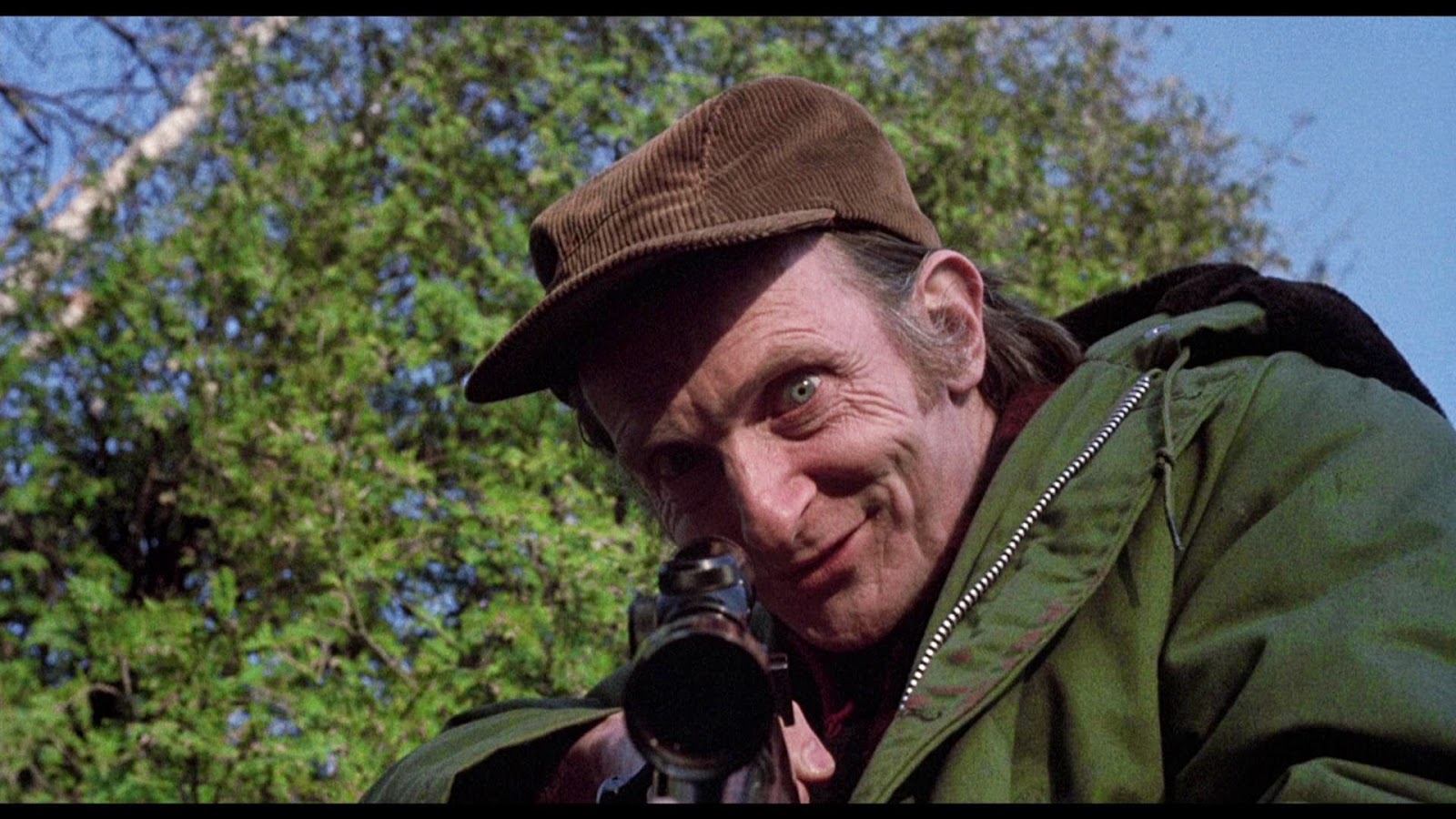
Released in February of ’74, it appears that Deranged beat The Texas Chainsaw Massacre’s release by mere months. Both films (and many others) use the insane grave-robber Ed Gein as inspiration. (“Gein” rhymes with “wine”, if you’re interested.) Though, it’s Deranged that stays truer to the Wisconsin serial killer’s story.
While The Texas Chainsaw Massacre may be more terrifying, Deranged is much more fun. Much of its charm comes from the casting of Roberts Blossom as the ersatz Ed Gein, Ezra Cobb. Blossom had been a veteran TV actor, with a few movies to his credit, as well. (He’s the guy in Close Encounters who announces he saw Bigfoot once.) Blossom’s acting here is quite effectively creepy and realistic.
Perhaps it’s the special effects by relative newcomer Tom Savini that stick out most in viewers’ memory. There is an infamous scene of Ezra cutting the top of a skull off with a saw, then “scooping” up the now-accessible brain with a spoon. (The brain-scooping scene was cut in the U.S. in order to secure an R-rating.)
In Deranged, though, its Roberts Blossom’s rural cannibal Ezra Cobb that remains hauntingly chilling. Due to its cinema-verite style, there is no score, which adds more realism to the movie. The directing pair went for a pseudo-documentary approach.
No, it’s not a very “scary” movie, and it doesn’t have any jump-scares. Director Bob Clark passed on this project, but decided to produce it nonetheless. Deranged may make you jump out of your seat; to find the remote to stop the images before they become nightmare-fodder.
6. Delicatessen (1991, dir. by Jean-Pierre Jeunet and Marc Caro)
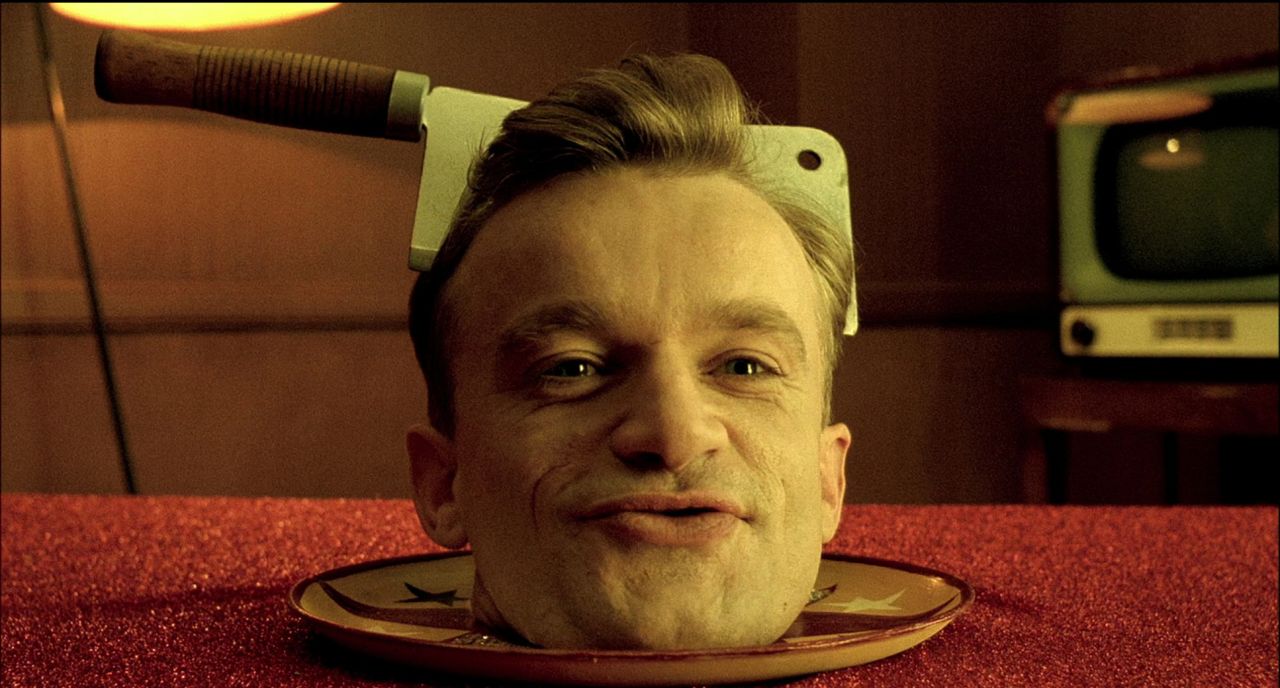
While Delicatessen takes place in a post-apocalypse future, with a butcher who lures in victims to be sold as meat; it is probably the most beautiful cannibal movie ever made. Directed by Marc Caro and Jean-Pierre Jeunut, t’s a stunning original, with terrific set-pieces and a whimsical script written by the two directors and Gilles Adrien. Their subsequent film, City of Lost Children would certainly prove that Delicatessen was no lucky mistake.
Here, they crafted a movie that is uniquely brilliant. It’s hard to think of any other film dealing with cannibalism that is also a “feel-good” film. Caro & Jeunut regular Dominique Pinon adds much to the movie, as the newest respondent to the ad placed by butcher Clapet (Jean-Claude Dreyfus) who happens to have been with the circus. For added enjoyment, there is an “underground” movement against the heartless butcher, and what his “cheap meat” contains.
It’s a one-of-a-kind movie-going experience that will have newcomers wondering why they took so long to see it.
5. The Hills Have Eyes (1977, dir. by Wes Craven)
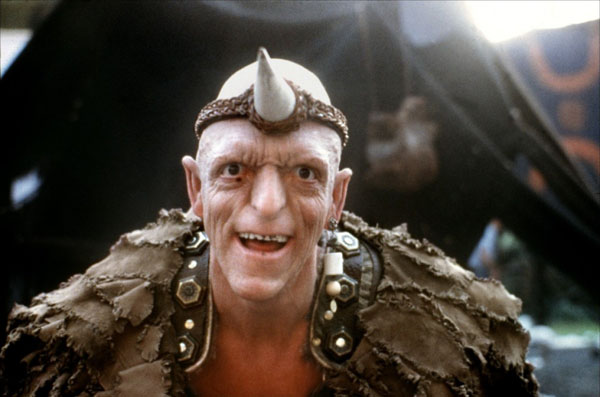
Horror-film legend Wes Craven’s follow-up to 1972’s The Last House on The Left, is a creepy, original, and scary entry in the horror history, also sliding perfectly into cannibal territory as well.
The story concerns the Carters; a family driving their mobile-home from Ohio to Los Angeles. Patriarch Bob determines that driving a whale through the Nevada desert is the way to go. Problems ensue when their RV crashes in the side of the road. Bob goes for help, and his family stay behind in luxury.
What Bob, and the Carters don’t know is that the surrounding desert, and hills, are home to a family of feral cannibals led by Papa Jupiter and his three children. They quickly set upon the RV containing all the Carters, who are anxiously awaiting dad’s return.
Thematically similar to Straw Dogs, Wes Craven shows us the violence inside all. Craven definitely pulls none of his rather-graphic punches here; the movie contains baby-napping, rape, and cannibalism. The crazed “family” includes Michael Berryman as Papa Jupe’s son Pluto. Berryman has such an unforgettable visage that the film’s one-sheet wisely features him looking his deranged best. It’s an image that has become iconic in the genre.
4. The Texas Chainsaw Massacre (1974, dir. by Tobe Hooper)
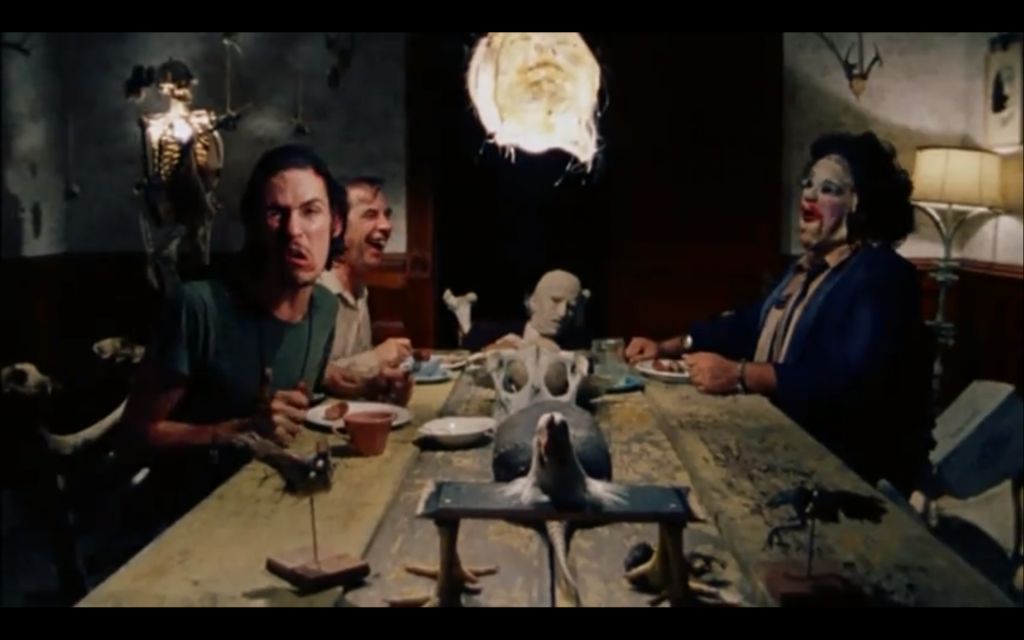
Though Tobe Hooper’s The Texas Chainsaw Massacre is not the first film to feature cannibalism, it remains the most terrifying of them all. As opposed to other directors’ handling of cannibalism, Hooper never explicitly shows the process. The Texas Chainsaw Massacre never overtly explains to the audience why the family is killing the harmless hippies, but there remains little doubt to the victims’ fate at the film’s end.
That’s part of the reason the results are so effective. Despite the controversies and reception The Texas Chainsaw Massacre received upon its release, on hindsight, there was scant evidence to back that up. It isn’t blood or guts that makes it so successful, it’s the pervasive mood and tone that really got under people’s skin.
Tobe Hooper’s horror drive-in masterpiece rightly deserves its standing as one of the most terrifying films in “the annals” of film.
3. The Silence of The Lambs (1991, dir. by Jonathan Demme)
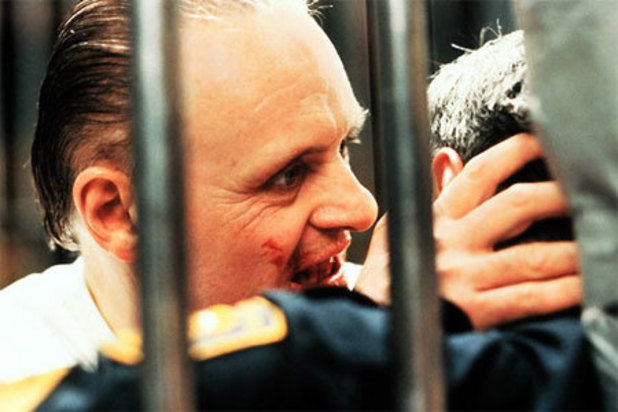
No respectable conversation of the cannibal genre would be complete without prominently featuring Hannibal “The Cannibal” Lector. Anthony Hopkins’s portrayal of the vicious serial killer won him an Oscar, a rarity for any horror film. In fact, there were Oscars all-around for practically everyone involved, even one for “Best Film.” It remains, to date, the last time a horror film would win the top prize.
Hopkins would reprise his super-villain anti-hero role a couple more times, though never as effectively as in the first, The Silence of The Lambs. (Some find Brain Cox’s 1986 portrayal in Manhunter to be much more faithful to the source novels by Thomas Harris. Cox certainly played Lector in a much more subtle, realistic way.) Hopkins gets creepier and scarier as the film moves along, and is astoundingly brilliant.
Director Jonathan Demme keeps everything moving along at the perfect clip, handling the complicated plot perfectly, never confusing the audience.
Unfortunately, Demme hasn’t equaled the success of this cannibal classic, though many of his previous films are minor classics in their own right. (see Melvin and Howard and Stop Making Sense)
2. Cannibal Holocaust (1980, dir. by Rugero Deodato)
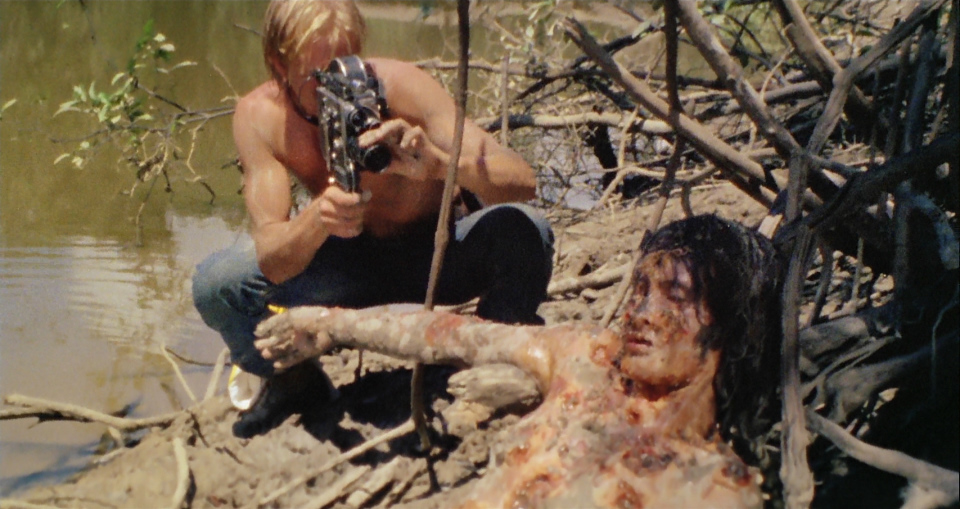
Cannibal Holocaust was one of the first films to exploit the idea of “found footage.” The concept here is that a film crew consisting of three men, and one woman go into the Amazon jungle to document cannibal tribes. The four are never seen again. A professor from NYU, Harold Monroe, quickly leads a rescue team into the jungle to find the lost, presumed-alive crew. The new Monroe-lead team soon come face-to-face with an indigenous tribe called The Yacumo.
After arriving at the tribe’s village, Monroe learns that the four documentarians had been there. Naturally, Professor Monroe and his team carry on until they stumble upon yet another tribe, The Yanomamo. The rescue team seem to be welcomed, only to discover the ghastly remains of the crew they had been looking for. Thankfully, the footage is found, and the team return to New York. Whew! Quite an ordeal.
As expected, news of the rescued footage spreads to the media. But what do the local television station executives want? Well, they want to show the found footage on TV in a documentary they’ll make about the missing film crew. Professor Monroe is not a big fan of this idea. He makes the bold decision to watch the footage. (Evidently, no one had as-yet bothered to take a peek.)
Here, the film posits that we’re going to be watching a true documentary. The “actual footage” shot by the four filmmakers shows scenes of the Yacumo tribe’s rituals, and ends with the entire tribe being set on fire by the film crew. (?) And, believe it or not, the professor is concerned with his realization that the scenes of the burning tribe were staged by the crew!
More of the found film is shown, including the film crew’s astounding idea of gang-raping one of the Yanomamo girls. Not such a good idea, as it turns out, because the last part of the found footage shows in disgusting detail the fate of the three men and the lone woman.
Cannibal Holocaust’s fame, or infamy, is a result of many viewers’ belief that the film was indeed a documentary, a…if you will, “shockumentary.” The problem here is that there’s not one natural actor amongst them all. They’re just not convincing. In the end, what viewers are left with is a film-within-a-film, real footage of animal slaughter, and tame gross-out special effects. Just a glance will show you that it is not a snuff film.
Over time Cannibal Holocaust would have much read into it. Critics claim it is a statement about society that’s very deep and profound. It’s really neither. Cannibal Holocaust will always have its supporters, and those who claim that it’s one of the best horror films ever made. It certainly remains controversial, while still at the top of the heap of cannibal movies.
1. Cannibal Ferox (1981, dir. by Umberto Lenzi)
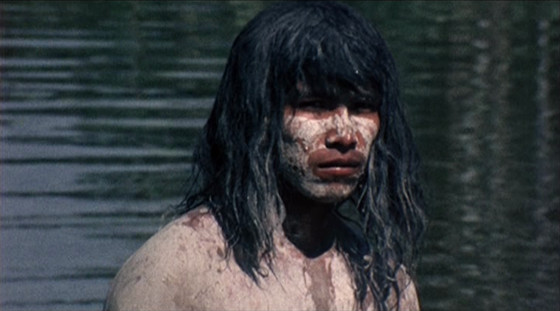
More disturbing than Cannibal Holocaust, this film contains scenes of torture that have made it widely-known. Gianetto de Rossi is to thank for the realistic special-effects, most infamously remembered by the scene where a woman is hoisted high, by hooks through her breasts. Here again; once seen, never forgotten.
The plot is needlessly complicated. At the start, there’s a guy involved in buying heroin in New York City. Then the mob enters. Then the action moves to Paraguay. Brother and sister Rudy and Gloria take their friend Pat into the rain forest. Why? Obviously, it’s to prove to stubborn Pat that there is nary a cannibal left. Their fun-filled jaunt is soon interrupted by Mike and his friend Joe. Seems the two were attacked by cannibals. That night, Gloria goes missing and Rudy goes off to find her.
Incoherently enough, the badly-injured Joe explains that he and his pal were the catalysts for the cannibals violence. Poor Joe. He just went to the region to find emeralds and…oh yeah: cocaine. Mike, with his violent temper, had other plans. It’s all Mike’s fault, dammit. His drug-fueled binges led to the killing of a tribal girl, and the torture and death of the pair’s guide; all in full view of the natives.
Killings, torturing, and cannibalism on display, as well as the requisite animal torture. Apparently, Italian cannibal directors love inserting real footage into the filmed scenes of violence. They believe it gives all the depravity going on before and after a certain sense of realism. It’s certainly a specious defense for the killing of animals on film.
But it’s really the torture scenes that separate this movie from the rest. Again; there aren’t any real scares to be had, but it could be argued that this itty-bitty sub-genre of “Italian cannibal movies” is the precursor to the glut of torture-porn, SAW-esque non-horror. It’s probably a good thing that those films have been disappearing from theaters.
U.S. distributers of Cannibal Ferox claimed it was “the most violent film ever made.” Of course, the tag is hyperbolic; but mainly because of the “woman hanging” scene, it could be the hardest to watch of all the cannibal movies… so far.
Author Bio: Christian Olson is a Chicago Comedian/Improvisor/Actor who hates writing about himself in the third person.